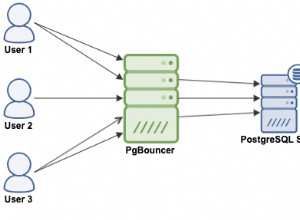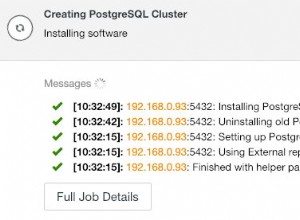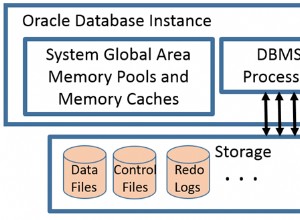Saya telah melihat implementasi yang sangat efektif dari ini yang berjalan sebagai berikut:
TABLE audit_entry (
audit_entry_id INTEGER PRIMARY KEY,
audit_entry_type VARCHAR2(10) NOT NULL,
-- ^^ stores 'INSERT' / 'UPDATE' -- / 'DELETE'
table_name VARCHAR2(30) NOT NULL,
-- ^^ stores the name of the table that is changed
column_name VARCHAR2(30) NOT NULL,
-- ^^ stores the name of the column that is changed
primary_key_id INTEGER NOT NULL,
-- ^^ Primary key ID to identify the row that is changed
-- Below are the actual values that are changed.
-- If the changed column is a foreign key ID then
-- below columns tell you which is new and which is old
old_id INTEGER,
new_id INTEGER,
-- If the changed column is of any other numeric type,
-- store the old and new values here.
-- Modify the precision and scale of NUMBER as per your
-- choice.
old_number NUMBER(18,2),
new_number NUMBER(18,2),
-- If the changed column is of date type, with or without
-- time information, store it here.
old_ts TIMESTAMP,
new_ts TIMESTAMP,
-- If the changed column is of VARCHAR2 type,
-- store it here.
old_varchar VARCHAR2(2000),
new_varchar VARCHAR2(2000),
...
... -- Any other columns to store data of other types,
... -- e.g., blob, xmldata, etc.
...
)
Dan kami membuat urutan sederhana untuk memberi kami nilai integer tambahan baru untuk audit_entry_id :
CREATE SEQUENCE audit_entry_id_seq;
Keindahan tabel seperti audit_entry adalah Anda dapat menyimpan informasi tentang semua jenis DML- INSERT , UPDATE dan DELETE di tempat yang sama.
Misalnya, untuk menyisipkan, pertahankan old_* kolom null dan isi new_* dengan nilai-nilai Anda.
Untuk pembaruan, isi keduanya old_* dan new_* kolom setiap kali diubah.
Untuk menghapus, cukup isi old_* kolom dan simpan new_* nol.
Dan tentu saja, masukkan nilai yang sesuai untuk audit_entry_type .;0)
Kemudian, misalnya, Anda memiliki tabel seperti berikut:
TABLE emp (
empno INTEGER,
ename VARCHAR2(100) NOT NULL,
date_of_birth DATE,
salary NUMBER(18,2) NOT NULL,
deptno INTEGER -- FOREIGN KEY to, say, department
...
... -- Any other columns that you may fancy.
...
)
Cukup buat pemicu di tabel ini sebagai berikut:
CREATE OR REPLACE TRIGGER emp_rbiud
-- rbiud means Row level, Before Insert, Update, Delete
BEFORE INSERT OR UPDATE OR DELETE
ON emp
REFERENCING NEW AS NEW OLD AS OLD
DECLARE
-- any variable declarations that deem fit.
BEGIN
WHEN INSERTING THEN
-- Of course, you will insert empno.
-- Let's populate other columns.
-- As emp.ename is a not null column,
-- let's insert the audit entry value directly.
INSERT INTO audit_entry(audit_entry_id,
audit_entry_type,
table_name,
column_name,
primary_key,
new_varchar)
VALUES(audit_entry_id_seq.nextval,
'INSERT',
'EMP',
'ENAME',
:new.empno,
:new.ename);
-- Now, as date_of_birth may contain null, we do:
IF :new.date_of_birth IS NOT NULL THEN
INSERT INTO audit_entry(audit_entry_id,
audit_entry_type,
table_name,
column_name,
primary_key,
new_ts)
VALUES(audit_entry_id_seq.nextval,
'INSERT',
'EMP',
'DATE_OF_BIRTH',
:new.empno,
:new.date_of_birth);
END IF;
-- Similarly, code DML statements for auditing other values
-- as per your requirements.
WHEN UPDATING THEN
-- This is a tricky one.
-- You must check which columns have been updated before you
-- hurry into auditing their information.
IF :old.ename != :new.ename THEN
INSERT INTO audit_entry(audit_entry_id,
audit_entry_type,
table_name,
column_name,
primary_key,
old_varchar,
new_varchar)
VALUES(audit_entry_id_seq.nextval,
'INSERT',
'EMP',
'ENAME',
:new.empno,
:old.ename,
:new.ename);
END IF;
-- Code further DML statements in similar fashion for other
-- columns as per your requirement.
WHEN DELETING THEN
-- By now you must have got the idea about how to go about this.
-- ;0)
END;
/
Hanya satu kata peringatan:selektif dengan tabel dan kolom apa yang Anda pilih untuk diaudit, karena bagaimanapun, Anda tabel ini akan memiliki banyak baris. SELECT pernyataan di tabel ini akan lebih lambat dari yang Anda harapkan.
Saya sangat ingin melihat implementasi lain di sini, karena ini akan menjadi pengalaman belajar yang baik. Semoga pertanyaan Anda mendapat lebih banyak jawaban, karena ini adalah implementasi terbaik dari tabel audit yang pernah saya lihat dan saya masih mencari cara untuk membuatnya lebih baik.




